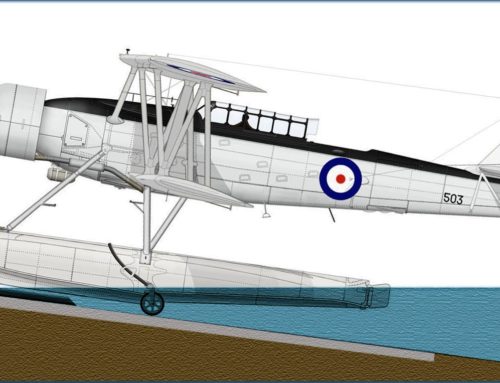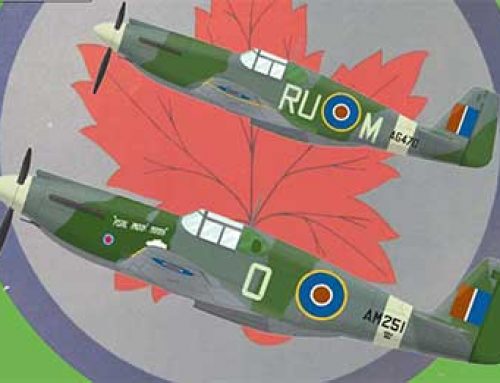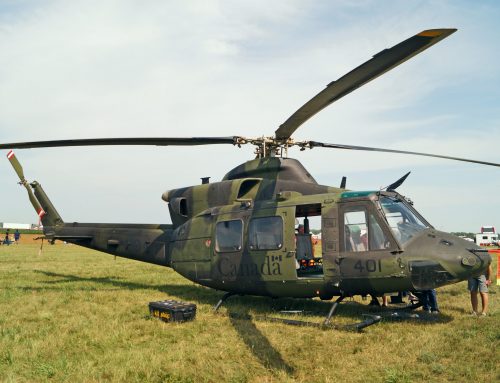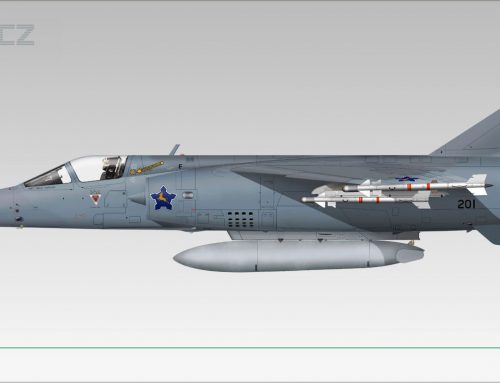The most visible difference between a CF-18 and a US F-18 is the night identification light.
This spotlight is mounted in the gun loading door on the port side of the aircraft. Some CF-18s have the light temporarily removed, but the window is always in place, with a protective cover mounted inside the door instead of the spotlight.
Additionally:
- The F-18C has two ECM ‘bumps’ on the dorsal hump directly behind the cockpit; these are not on the CF-18
- The F-18C has two extra sets of ECM ‘bumps’ on the nose. These are situated just under the ahead of the cockpit, and aft and higher than the F-18A ECM ‘bumps’ directly behind the radome. These two extra sets of ECM bumps are not on the CF-18.
The tops of the tailfins may not be the same as your model kit. There are a number of strengthening plates that have been added to the CF-18 during its life that now make the fins slightly different from most US aircraft.
The communications and ECM antennae configuration varies a bit from US aircraft. The exact configuration of a particular CF-18 varies depends on the stage of modifications and upgrades that are routinely performed on them.
On the sides of the fuselage, between the cockpit and radome, some CF-18s have a small door that accessed the ground emergency canopy jettison system. This system was only installed on CF-18A 701 to 747, and CF-18B 901 to 919. It has now been deactivated on all CF-18s although the panel (with no markings) remains on the A/C listed. The remaining jets (748 to 798 and 920 to 940) do not have this door on the airframe.
A less-obvious difference is on the main landing gear. Compared to US F-18A to D models, the big hydraulic shock absorbers are mounted upside-down on the CF-18. American F-18s have the shiny part of the piston pointing up, and the CF-18 uses a different shock absorber that has the piston pointing down.
The cockpit configuration of the CF-18A/B is very similar to the US F-18A/B; this is somewhat different from the F-18C/D aircraft. CF-18s use the Martin Baker SJU-9/A and -10/A model seat, which is painted matt black. This seat is essentially identical to early American F-18s, with some noteworthy differences in the seat strap and harness configuration. (F-18 pilots wear a parachute harness that is then attached to the seat; CF-18 pilots strap into the seat where the harness is integrated with the seat itself). Starting in 1997, the CF-18 fleet was gradually modified to carry two cockpit video recording cameras. These are mounted on the canopy frame to either side of the pilot.
The colours used on the CF-18 are now matched to the US FS595b standard:
- top surfaces are Blue/Grey 35237
- lower surfaces are Grey 36375
- ‘false canopy’ is Grey 36118
- cockpit is painted Grey 36231, with the inside of the canopy frame and upper cockpit decking in matt black
- wheel wells are gloss white
- inner surfaces of the undercarriage doors are gloss white with gloss red edge trim
- A feature on the CF-18 is to have the ‘last 3’ numerals of the aircraft’s serial number painted in small red or black characters on the inner surface of each undercarriage door.
For operational aircraft, the squadron markings are normally located at the top of the tailfins. They are painted on the aircraft using the camouflage grey colours listed above. The exception to this is 441 ‘Silver Fox’ Sqn, which carries a black and white checkerboard for a unit marking. Some CF-18s also carry additional unit markings or slogans on the LEX fences. You almost always see pylons and occasionally drop tanks carrying some sort of Sqn identifying mark on them, mostly as an easy method for a unit to maintain control over its equipment.
Nearly all markings on the CF-18 are painted in the opposite camouflage colours, i.e., on the 35237 parts of the aircraft the markings are in 36375, and vice versa. A few small markings are painted in black, and the ‘last 3’ nose numbers are usually painted in Grey 36118.
Like the F-18A/B, the CF-18 has nine stores stations:
1 & 9 (wingtips): LAU-7/A launcher for an AIM-9M or ACMI pod
2 & 8 (outboard wing): SUU-63/A pylon*; for weapons only
3 & 7 (inboard wing): SUU-63/A pylon*; for weapons or 330 gal fuel tank
4 & 6 (fuselage ‘corners’): single AIM-7M missile, or an AN/AAS-38 Nite Hawk laser targeting pod (only since 1997; carried on the port side only).
5: fuselage centreline: SUU-62 pylon; for a 330 gal fuel tank, a single weapon, or a VER-33/A.
* There are two variations of the SUU-63/A pylon: the standard ‘skinny’ version, and the modified ‘fat boy’ version. This latter pylon can now carry the ALQ-162 ECM set and can be identified by being visibly wider at the aft end, as well as having a small conformal antenna at the front and back ends of the pylon. These pylons are normally carried one per aircraft, but can be carried in any pylon position on the airplane.
For multiple stores carriage on the SUU-62 or SUU-63 pylons, the CF-18 carries the BRU 33/A Vertical Ejector Rack (VER). The CF-18 is not cleared to use the US TER or MER. The CF-18 can carry the following operational weapons:
- AIM-7M Sparrow air-to-air missile, carried on either a LAU-116 (fuselage mount) or the LAU-115 launcher (for wing pylon mount)
- AIM-9M Sidewinder air-to-air missile, on a LAU-7/A launcher (on the wingtips or on a wing pylon via a LAU-115 launcher)
- (starting in 1997) AGM-65G Maverick air-to-ground missile (wing-mounted on a LAU-117 launcher)
- CRV-7, 2.75″ air-to-ground rockets carried in LAU-5003 19-shot pods
- Mk.20 Rockeye air-to-ground sub-munitions dispenser. These weapons gradually replaced the British BL 755 sub-munitions dispenser, which were initially used on the CF-18
- Free-fall bombs: Mk.82 (500 lb), Mk.83 (1000 lb), and Mk.84 (2000 lb). The CF-18 uses these with low-drag tails or high-drag tails depending upon the mission requirements
- (starting in 1997) Laser-guided bombs: GBU-10 (2000 lb), GBU-12 (500 lb), GBU-16 (1000 lb), and GBU-24 (a 2000 lb BLU-109 penetration weapon).
In the late 1990’s it was decided that 80 CF-18s (out of the 122 currently remaining in service) would undergo a major modification and upgrade program called Engineering Change Proposal 583. Like other F-18A/B users around the world, under ECP-583 and other proposed changes, the CF-18 would be substantially modified to meet the new threats and operating conditions of today, becoming a more potent all-weather fighter with new mission computers, software, radar, radios, identification system, armament, and defensive electronic-warfare systems.
In a nutshell, the changes to the CF-18 will be:
- an omnibus incremental modernization project
- specific modifications to the CF-18 weapons suite (air-to-air missiles, air-to-surface weapons and sensors)
- various other stand-alone projects which will all contribute to the CF-18’s final capability
The four major projects already in the implementation phase include:
- upgrades to the mission computers and their software
- a baseline avionics upgrade package (Engineering Change Proposal [ECP] 583) (The project includes such things as Jam-Resistant Secure Radios, the APG-73 Radar, Combined Identification Friend or Foe Interrogator/Transponder (CIT) and an advanced Stores Management System (SMS).)
- a new high-tech air combat instrumentation system, which allows pilots to train and re-create training missions for detailed, ground-based debriefing purposes
Boeing proposed a version of the US Engineering Change Program 583 (ECP-583) which is being used to upgrade all US Navy and Marine Corps F/A-18s to the latest C/D standards. This plan was modified somewhat to accommodate the Canadian requirements (the standard US ECP-583 plan was deemed too inflexible for Canadian requirements). Government of Canada approval to award the Canadian ECP-583 contract to Boeing as the prime contractor was given in August 2000. The ECP-583 plan will see the integration of the features originally planned for the IMP, but on a different timescale, in two phases versus the original three, and with Boeing as the manager of the program, increasing efficiency and reducing costs. This way, the modernization programme will occur simultaneously with the US ECP-583 programme, further saving costs and increasing efficiency.
Some more information on some of the items to be included in the program:
Aside from acquisition of the AN/APG-73 radar, other items include the new jam-resistant radios will be the Rockwell Collins AN/ARC-210 TR-1556 Have Quick II radios, which will replace the non-secure open-voice systems which became a potential liability during Allied Force.
Current mission computers will be replaced with the XN-8 sets acquired under FMS, and the aircraft will finally get an integrated GPS/INS in the form of the CN-1694(V)4/ASN-172(V); A tactical datalink in the form of the NATO-standard Link-16 datalink is also being acquired.
IFF gear will be integrated for the first time in the CF-18, using the BAE Systems AN/APX-111. In addition, the monochrome cockpit CRTs will be replaced by Litton Systems Canada Active-Matrix Liquid Crystal Displays (AMLCDs) as well as displays from Kaiser Electronics, as the current ones are obsolescent, and the manufacturers are no longer able to provide support. The AMLCDs being acquired are a smaller version of the ones being integrated with the F/A-18E/F Super Hornet, reduced in size to fit the smaller A/B/C/D cockpits.
The CF-18’s defensive electronic warfare (EW) suite will be fully revamped under the modernization programme, with the acquisition AN/ALQ-126B pulse-jammer and AN/ALQ-162 continuous-wave jammer, missile approach and warning system (MAWS), as well as upgrades to the chaff and flare dispensers (which will fire the new pyrophoric flares designed to defeat the more advanced seeker algorithms incorporated into the latest IR-guided missiles). Also, the current AN/ALR-67 radar-warning receiver (RWR) will be replaced, but no word has been released on which model will be acquired. The modifications to the overall CF-18 EW systems are so extensive that there is some speculation that all the projects will be combined to acquire a complete defensive EW suite.
Other projects that are being conducted in parallel are the IRIS-T programme to replace the AIM-9M, which will see Canadian acquisition of the IRIS-T, expected to go ahead from 2002-2005 for a total cost of $80.9M (CDN). Along with the IRIS-T, the Air Force will invest $50M (CDN) in a helmet-mounted sight to allow CF-18 pilots to take the IRIS-T’s high off-boresight capability to its full potential. No word on which sight will be purchased, but probably the likeliest candidate would probably be JHMCS. Also, the need to replace the AIM-7 Sparrow has finally been identified, as the current APG-65/AIM-7 combination is unable to fulfill NATO and NORAD requirements for low-observable and multiple air-to-air target engagement. There is no word yet on which missile will be acquired to replace the rather notorious Sparrow, but the obvious choice is of course the AMRAAM, probably in its latest AIM-120-C5 variant, recently approved by the US Government for export to US allies, incorporating improvements including better ECCM, improved warhead, and a 5-inch rocket engine extension made possible through avionics miniaturization. Other weapons-related projects include the purchase of additional NiteHawk FLIR pods, and more PGMs; the Air Force has continued to express interest in GPS-guided munitions such as the JDAM, but at present the only project funded is the acquisition of additional LGBs to replenish stocks depleted during Allied Force.
Other modernization projects underway include the $9M (CDN) NVG project, as well as what are described as “possible stealth enhancements”. According to Jane’s, CF-18s will also undergo the Centre Barrel Replacement Plus (CBR+) structural upgrade programme, which will see the current centre barrel in the airframe being replaced with a thicker unit. Under the revised IMP timeline, the first aircraft will enter the modernization programme in 2002, with the last one being completed by 2006; it is estimated the first fully-upgraded squadron will be ready by 2003. The programme will see the aircraft essentially brought up to the latest USN/USMC F/A-18C/D level of capability, and see the lifespan of the CF-18 fleet extended to the 2017-2020 timeframe. There is currently no formal work being undertaken to replace the CF-18, though there is some speculation that preliminary CF-18 replacement planning could begin within the next 2 to 5 years.





